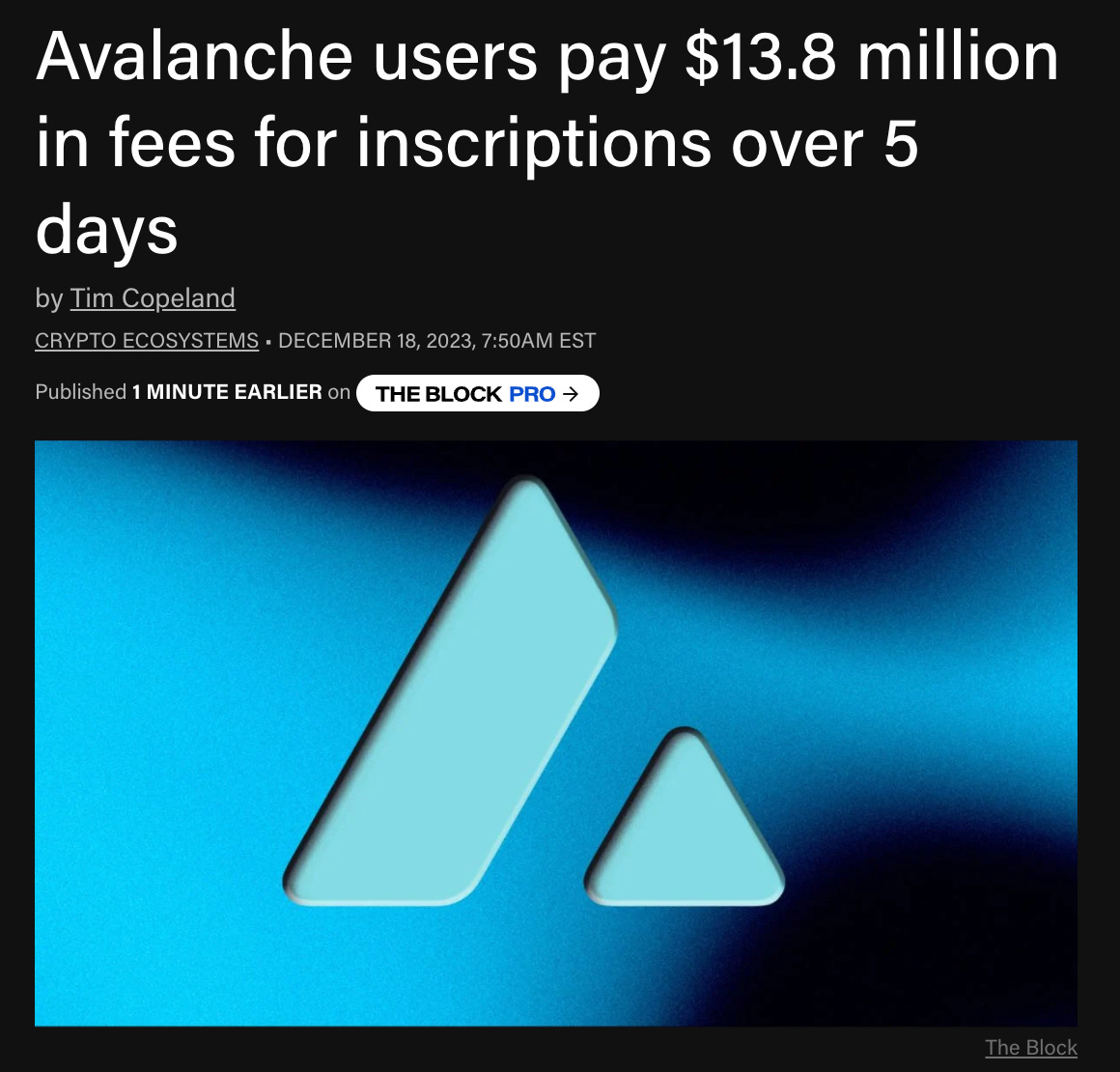Inscriptions: The Blockchain Cloggers
Looking at the nuts and bolts from a layman's perspective of what's going on behind the scenes.
GM! (from the mile-high city...)
If you need a reminder of me and my background visit here. Else, welcome to the 12th edition of NotCryptoBro’s Memo. It’s alt-coin, meme-coin, and inscription season.
But today’s memo is about Inscriptions. Btw, none of that needs to make sense to you but, you are here, might as well learn something new.
Onwards!
Boring stuff.
Inscriptions are causing significant network outages and spikes in gas fees on multiple blockchains.
Last Friday, Arbitrum was down for over an hour. The reason?
“A sustained surge of inscriptions triggered the sequencer to stop relaying transactions properly.”
Over the past five days, Avalanche users have paid over $14 million in gas fees for transactions – that's much, much more than what Avax users typically pay.
That’s not all – other chains are also congested by the surge in inscriptions. In the past week, the majority of transactions on EVM chains have been inscription transactions.
Avalanche – 91%
Gnosis – 75%
Goerli – 65%
Arbitrum – 62%
ZkSync Era – 58%
Polygon – 40%
Fantom – 32%
But WTF are inscriptions?
...you are in luck today.
WTF Are Inscriptions?
Inscriptions enable direct data embedding on blockchain transactions.
For example, you can attach the metadata (an image) of an NFT to a transaction.
If you do, that image will live inside that transaction (on-chain) forever.
So technically, you're putting a piece of data on-chain without the need for a smart contract.
That’s revolutionary for Bitcoin – which doesn’t support smart contracts – because it allows NFTs or other tokens to be built (kind of) on Bitcoin.
Using this concept, Bitcoin Ordinals took off in popularity earlier this year, and so far, 50 million inscriptions have been inscribed on Bitcoin.
And BTC miners have collected more than $200 million in transaction fees.
But inscriptions didn’t stop there – they’re now coming to EVM chains like Ethereum, Arbitrum, Avalanche, Polygon, and BNB.
But why would they do that? These chains already support smart contracts with the ability to mint NFTs and tokens. Why do they also need inscriptions??
Inscriptions vs. NFTs
Inscriptions imitate NFTs and fungible tokens like ERC-721 and ERC-20 but with a significant cost advantage.
They avoid the high gas fees typically associated with smart contracts.
The process for inscriptions is simple:
You create a transaction, often sending it to yourself, with no actual currency exchanged
This transaction includes 'calldata' that specifies your action (like minting tokens)

Calldata is data attached to a transaction, providing instructions in a read-only format.
If let’s say, you attach an image of yourself to this transaction, that would mean that your image is forever inscribed onchain, living in this transaction.
Because this data was stored in a simple transaction, its storage costs are much, much cheaper than if this data lived in a smart contract.
So, the main differences between inscriptions and standard NFTs are:
Inscriptions record intended actions, such as minting or transferring tokens, within the transaction's metadata.
NFTs involve actual transfers or creations on the blockchain, as per the smart contract's code.
The Catch, Hiding In Plain Sight.
Inscriptions store all your activities and data on-chain, as a form of notes (calldata). Since this calldata is stored in multiple random transactions, making sense of the data in real-time is almost impossible.
Put simply, if you’re putting an image onchain via an inscription, it’ll be there forever, but nobody will know.
Unless (wait for it)... you use a centralized API that is actively indexing the inscribed data.
This means that to understand the current status of an inscription token or collection, you need to rely on a third-party (centralized) indexer to provide this data to you.
[Indexers are systems (operating off-chain) that organize and simplify blockchain data, making it easier to access and use.]
As a result:
Smart contracts cannot directly access this data.
Applications cannot read this data straight from the blockchain.
As a result, you lose all of the benefits of NFTs that operate using smart contracts (interoperability, composability, etc.)
For example, in RugbyDAO, they give Founder Passes (NFTs) to core members. If these were inscriptions, by owning one, you wouldn’t be able to access their Discord (hypothetically) unless they used a centralized service.
However, because our PRO Passes are tokens using smart contracts (Polygon-based), they can set parameters that allow only holders of this specific token to enter their (hypothetical) token-gated Discord.
So, inscriptions have limited use cases. They primarily serve as immutable on-chain art, but that's it.
On the other hand, NFTs have millions of use cases because they operate using smart contracts.
Conclusion.
Inscriptions are great for Bitcoin, which doesn’t support smart contracts, but for EVM chains, they’re not adding anything new to the table.
You could argue that this is a step back for blockchain technology, as inscriptions encourage off-chain activity (indexers), which goes against the ethos of web3.
So why is everyone creating, transferring, and buying inscriptions?
The primary motivation seems to be the eagerness to replicate the success of BRC-20 tokens (Ordinals) seen on Bitcoin.
Everyone is now rushing to EVM chains, hoping to build the early collections on these chains.
However, a significant portion of this activity is merely repetitive minting by the same users or bots.
They’re able to spam transactions because they are far less expensive than transactions involving smart contracts.
Welcome to crypto. Welcome to your next hype cycle fueled by speculators, bots, and spammers. Let the fun begin!
Till next Thursday!
NotCryptoBro
[aka Rohan Handa]








